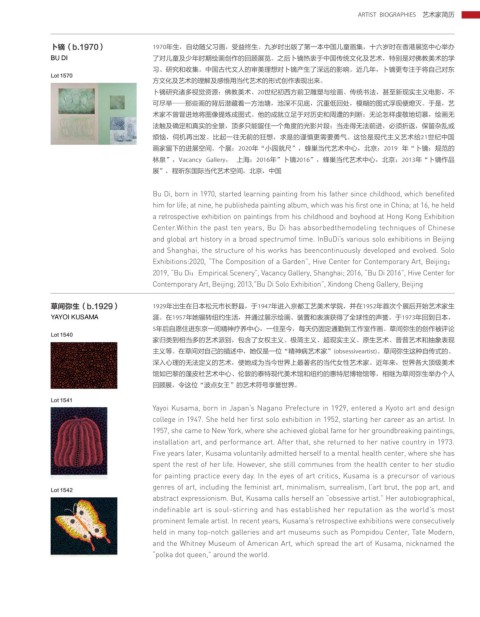Page 225 - 二十世纪及当代艺术
P. 225
ARTIST BIOGRAPHIES 艺术家简历
卜镝(b.1970) 1970年生,自幼随父习画,受益终生。九岁时出版了第一本中国儿童画集,十六岁时在香港展览中心举办
BU DI 了对儿童及少年时期绘画创作的回顾展览。之后卜镝热衷于中国传统文化及艺术,特别是对佛教美术的学
习、研究和收集。中国古代文人的审美理想对卜镝产生了深远的影响。近几年,卜镝更专注于将自己对东
Lot 1570
方文化及艺术的理解及感悟用当代艺术的形式创作表现出来。
卜镝研究诸多视觉资源:佛教美术、20世纪初西方前卫雕塑与绘画、传统书法,甚至新现实主义电影,不
可尽举——那些画的背后潜藏着一方池塘,池深不见底,沉重低回处,模糊的图式浮现便熄灭。于是,艺
术家不曾冒进地将图像提炼成图式。他的成就立足于对历史和周遭的判断:无论怎样虔敬地切慕,绘画无
法触及确定和真实的全景,顶多只能留住一个角度的光影片段;当走得无法前进,必须折返,保留杂乱或
烦恼,伺机再出发。比起一往无前的狂想,求是的谨慎更需要勇气。这恰是现代主义艺术给21世纪中国
画家留下的进展空间。个展:2020年“小园就尺”,蜂巢当代艺术中心,北京;2019 年“卜镝:规范的
林泉”,Vacancy Gallery, 上海;2016年”卜镝2016”,蜂巢当代艺术中心,北京;2013年“卜镝作品
展”,程昕东国际当代艺术空间,北京,中国
Bu Di, born in 1970, started learning painting from his father since childhood, which benefited
him for life; at nine, he publisheda painting album, which was his first one in China; at 16, he held
a retrospective exhibition on paintings from his childhood and boyhood at Hong Kong Exhibition
Center.Within the past ten years, Bu Di has absorbedthemodeling techniques of Chinese
and global art history in a broad spectrumof time. InBuDi’s various solo exhibitions in Beijing
and Shanghai, the structure of his works has beencontinuously developed and evolved. Solo
Exhibitions:2020, “The Composition of a Garden”, Hive Center for Contemporary Art, Beijing;
2019, “Bu Di:Empirical Scenery”, Vacancy Gallery, Shanghai; 2016, “Bu Di 2016”, Hive Center for
Contemporary Art, Beijing; 2013,"Bu Di Solo Exhibition”, Xindong Cheng Gallery, Beijing
草间弥生(b.1929) 1929年出生在日本松元市长野县,于1947年进入京都工艺美术学院,并在1952年首次个展后开始艺术家生
YAYOI KUSAMA 涯。在1957年她辗转纽约生活,并通过展示绘画、装置和表演获得了全球性的声誉。于1973年回到日本,
5年后自愿住进东京一间精神疗养中心,一住至今,每天仍固定通勤到工作室作画。草间弥生的创作被评论
Lot 1540
家归类到相当多的艺术派别,包含了女权主义、极简主义、超现实主义、原生艺术、普普艺术和抽象表现
主义等。在草间对自己的描述中,她仅是一位“精神病艺术家”(obsessiveartist)。草间弥生这种自传式的、
深入心理的无法定义的艺术,使她成为当今世界上最著名的当代女性艺术家。近年来,世界各大顶级美术
馆如巴黎的蓬皮杜艺术中心、伦敦的泰特现代美术馆和纽约的惠特尼博物馆等,相继为草间弥生举办个人
回顾展,令这位“波点女王”的艺术符号享誉世界。
Lot 1541
Yayoi Kusama, born in Japan’s Nagano Prefecture in 1929, entered a Kyoto art and design
college in 1947. She held her first solo exhibition in 1952, starting her career as an artist. In
1957, she came to New York, where she achieved global fame for her groundbreaking paintings,
installation art, and performance art. After that, she returned to her native country in 1973.
Five years later, Kusama voluntarily admitted herself to a mental health center, where she has
spent the rest of her life. However, she still communes from the health center to her studio
for painting practice every day. In the eyes of art critics, Kusama is a precursor of various
genres of art, including the feminist art, minimalism, surrealism, l’art brut, the pop art, and
Lot 1542
abstract expressionism. But, Kusama calls herself an “obsessive artist.” Her autobiographical,
indefinable art is soul-stirring and has established her reputation as the world’s most
prominent female artist. In recent years, Kusama’s retrospective exhibitions were consecutively
held in many top-notch galleries and art museums such as Pompidou Center, Tate Modern,
and the Whitney Museum of American Art, which spread the art of Kusama, nicknamed the
“polka dot queen,” around the world.

